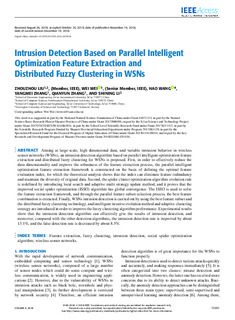| dc.description.abstract | Aiming at large-scale, high dimensional data, and variable intrusion behavior in wireless sensor networks (WSNs), an intrusion detection algorithm based on parallel intelligent optimization feature extraction and distributed fuzzy clustering for WSNs is proposed. First, in order to effectively reduce the data dimensionality and improve the robustness of the feature extraction process, the parallel intelligent optimization feature extraction framework is constructed on the basis of defining the optimal feature evaluation index, for which the theoretical analysis shows that the index can eliminate feature redundancy and maintain the diversity of original data. Second, the spider cluster optimization algorithm evolution rule is redefined by introducing local search and adaptive multi strategy update method, and it proves that the improved social spider optimization (ISSO) algorithm has global convergence. The ISSO is used to solve the feature extraction framework, and through the parallel feature subset selection process, the best feature combination is extracted. Finally, WSNs intrusion detection is carried out by using the best feature subset and the distributed fuzzy clustering technology, and intelligent iterative evolution method and adaptive clustering strategy are introduced in order to improve the fuzzy clustering algorithm performance. Experimental results show that the intrusion detection algorithm can effectively give the results of intrusion detection, and moreover, compared with the other detection algorithms, the intrusion detection rate is improved by about 13.1%, and the false detection rate is decreased by about 8.5%. | nb_NO |
